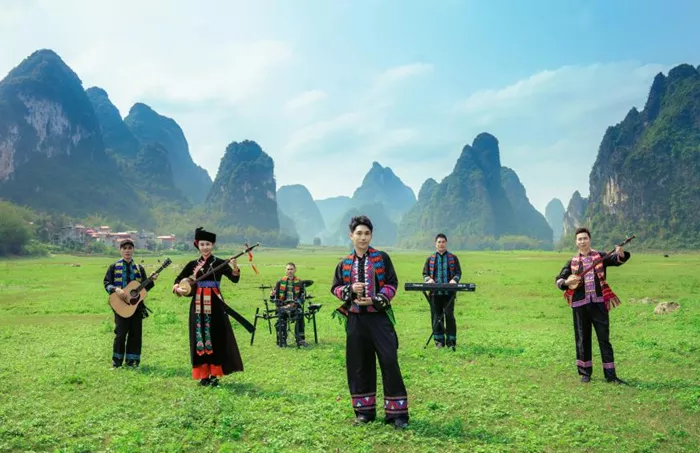In the picturesque backdrop of Guangxi Zhuang Autonomous Region’s verdant karst hills, a unique pop concert unfolds. Clad in embroidered ethnic costumes, a band of six musicians, hailing from the Zhuang ethnic group, combines traditional and contemporary sounds to captivate audiences.
Among the ensemble’s instruments are modern guitars, a keyboard, and a drum kit, alongside the distinctive Tianqin zithers – ancient instruments traditionally crafted from gourds and played like guitars. Once used solely for ritualistic purposes, the Tianqin is undergoing a revival, led by musicians like Dingding, a recently formed pop band comprising three school teachers, a factory worker, a former media professional, and a health worker, all aged between 31 and 48.
Residing in Longzhou County, within the city of Chongzuo, Guangxi, Dingding rehearses diligently twice weekly and stages performances in scenic locales. Supported by local authorities keen on integrating cultural heritage with tourism, their efforts align with broader initiatives to preserve the Tianqin art form. Recognized as a national-level intangible cultural heritage in 2021, Tianqin’s resurgence includes efforts to incorporate it into school curricula, refine its artistic delivery in colleges, and ensure its authentic transmission across generations.
Named after the Tianqin in the Zhuang language, Dingding innovatively merges this traditional instrument with Western elements and introduces Shan’ge, or “mountain songs,” a cherished genre of Chinese folk music, into their repertoire. Shan’ge, traditionally sung during rituals, incorporates improvised lyrics and is a cultural hallmark of Guangxi’s Zhuang people.
Lead singer Lu Qingcong explains, “To make Tianqin and Shan’ge more appealing to today’s youth, we blend them with popular music elements.” Their original song “Lei Ya,” featuring rap segments inspired by Zhuang finger-guessing games, has garnered praise on social media platforms.
Dingding’s experimentation extends to integrating electronic music into compositions celebrating local milestones, such as Longzhou County’s upcoming integration into China’s high-speed rail network. This fusion has sparked curiosity among audiences, drawing inquiries about Tianqin’s playing techniques and instruments.
Reflecting on challenges, Lu admits, “Balancing Tianqin’s timbre with other instruments can be tricky. When Tianqin leads, bass and guitar accompaniments adjust accordingly.” Qin Yan, a Tianqin player, underscores the linguistic nuances in Zhuang dialects, crucial for lyrical flow and natural pronunciation in their music.
Their upcoming release, inspired by childhood memories and Zhuang ballads, promises to deepen their cultural narrative. Ma Shaogang, band composer and Tianqin player, emphasizes their commitment to integrating Zhuang ethnic elements into contemporary pop, affirming, “Our culture forms our ‘roots,’ guiding our creative journey.”
Dingding exemplifies a harmonious blend of tradition and innovation, enriching cultural heritage while resonating with modern audiences eager to explore Guangxi’s vibrant musical tapestry.

